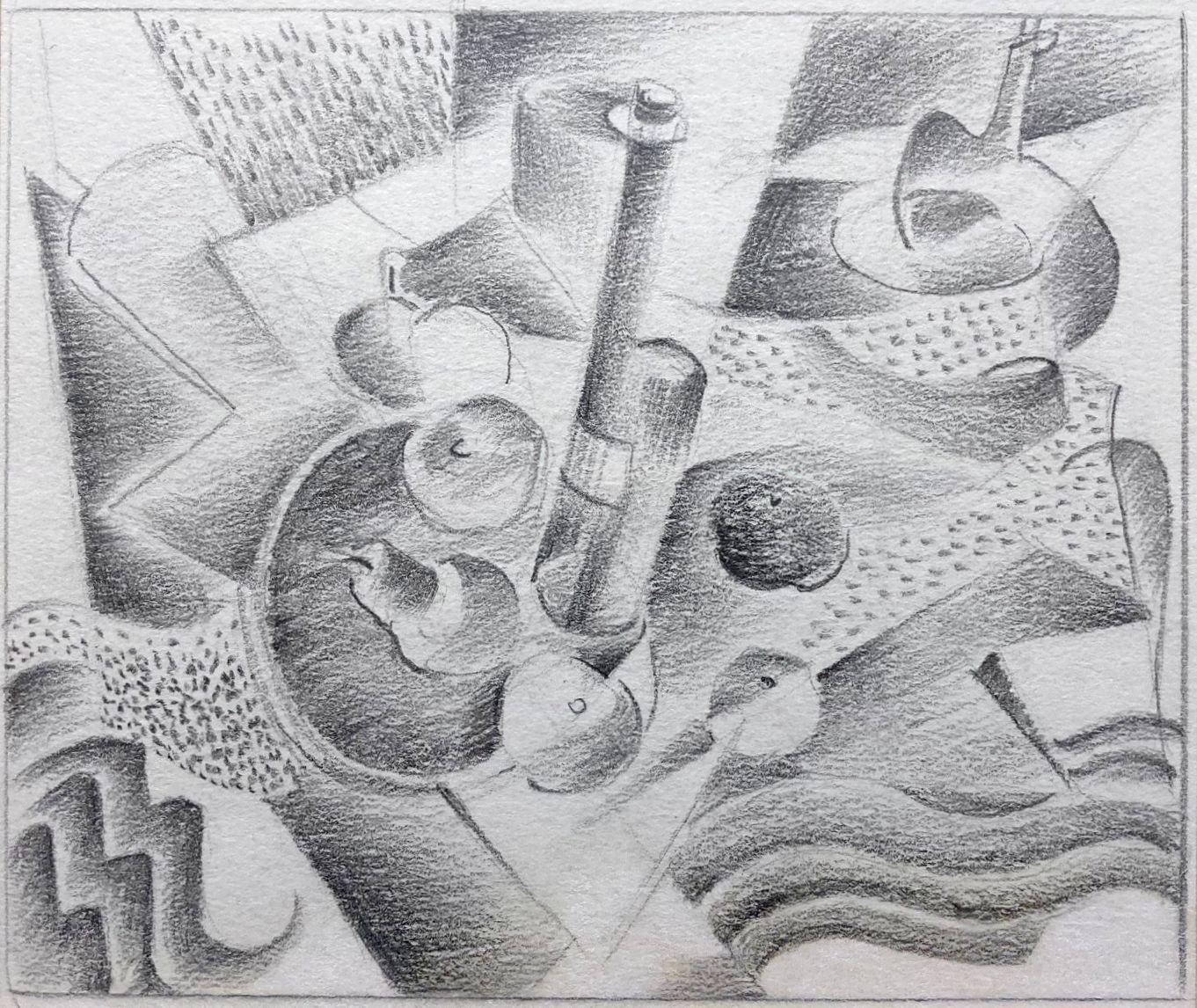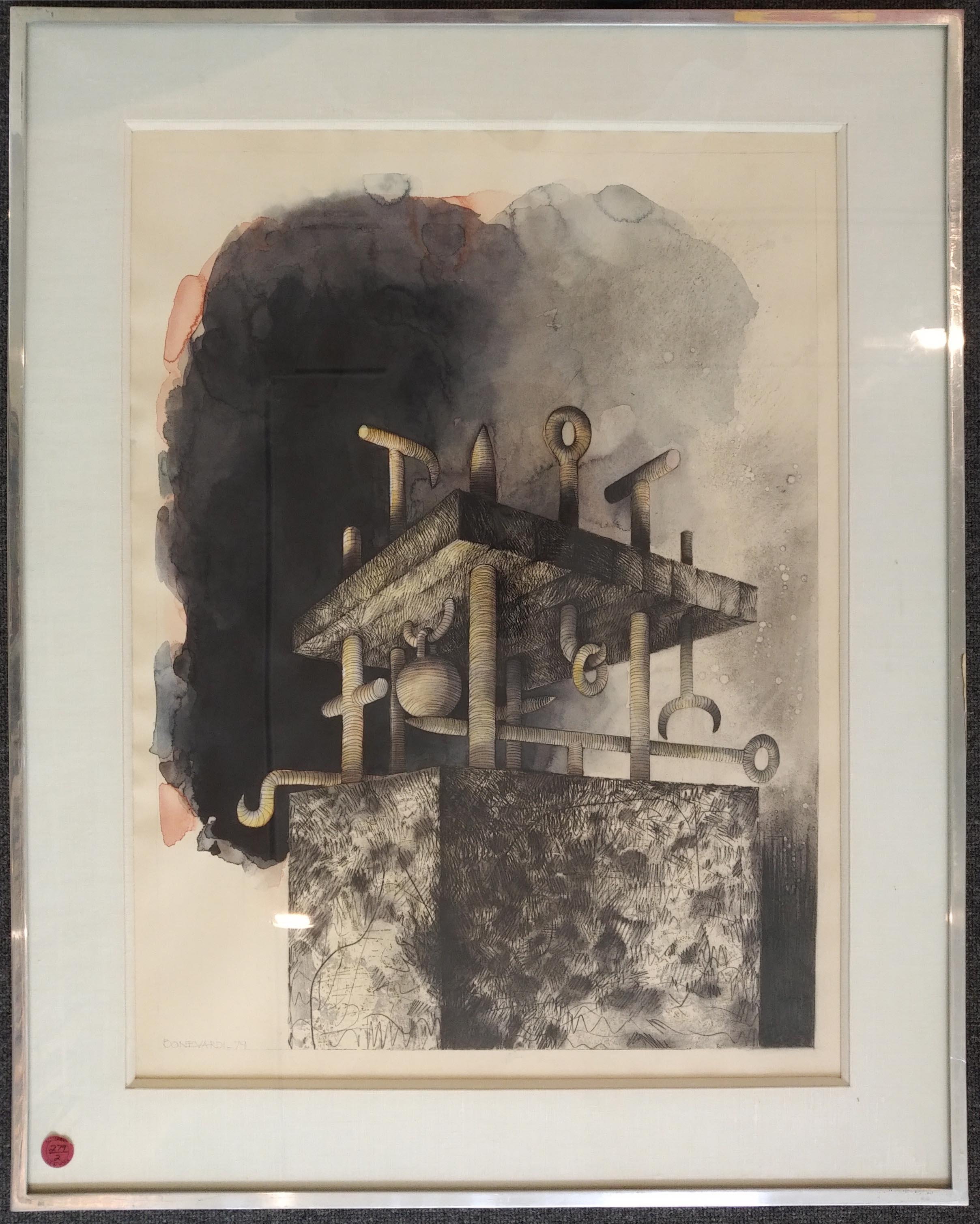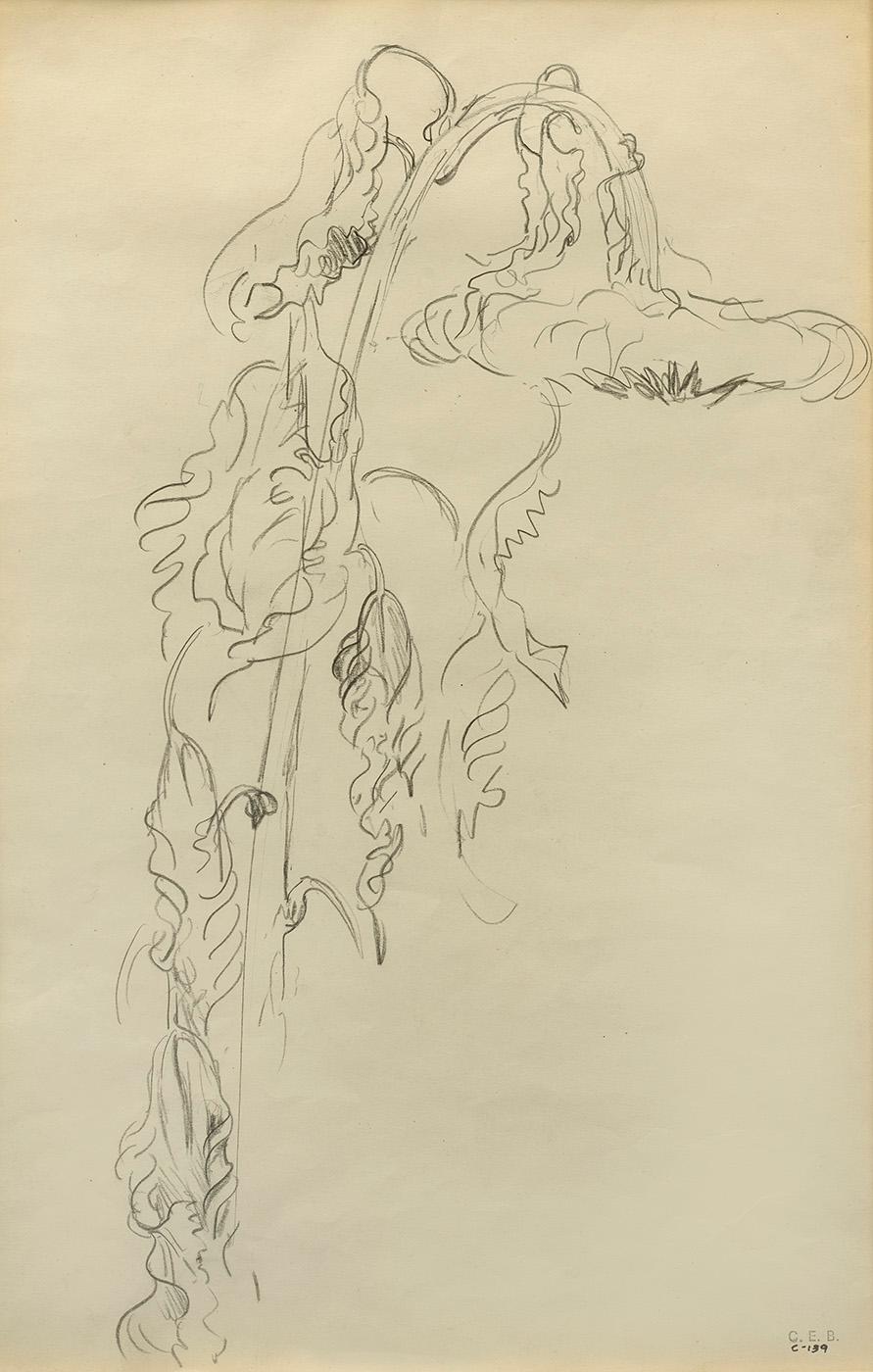Want more images or videos?
Request additional images or videos from the seller
1 of 5
Emil BisttramUntitled, Still Life of Shell1945-1951
1945-1951
About the Item
Untitled, Still Life of Shell
Graphite on paper, 1945-1951
Signed lower right in pencil "Bisttram" (see photo)
Condition: Excellent
Sheet size: 9.63 x 7 .5 inches
EMIL BISTTRAM (1895-1976) was born in Nadlak, Hungary, and baptized in the Romanian Greek Orthodox Church with the name Emilian Bistran. He immigrated to the United States in 1906 with his family. He grew up on the east side of New York and got involved with gangs and was expelled from school. Later he was enrolled in a vocational school and received some art training. He eventually worked his way up in advertising, having his own firm by 1920. He then sought out more art training under Howard Giles, who introduced him to the people and ideas who would be influential in his life – Jay Hambidge and his theory of dynamic symmetry, Denman Ross and his color theory, Nicholas Roerich, and Claude Bragdon. Bisttram made his first trip out West during the summer of 1930, visiting Taos, and then made application to the Guggenheim Foundation for a fellowship, which took him to Mexico City to study with Diego Rivera in 1931. Bisttram experimented with different styles, and by 1933 he was working with abstraction, by 1936 was making some overtly occult works, and by 1937 non-objective works influenced by Kandinsky. In 1938 he was instrumental in founding the Transcendental Painting Group made up of a group of 9 artists whose goal was to band together in order to promote their work and make a larger impact than any of them could do individually.
After World War II, TPG members went in different directions, and the Group disbanded. Bisttram went out to Phoenix (1941-1944) and then to Los Angeles (1945-1951) to teach in the winters, always returning to teach the Taos Summer School in the summers.
Emil Bisttram’s artistic career is of special interest because of the fascinating array of spiritual, philosophical, and scientific traditions he brought to bear on his painting. Profoundly spiritual and convinced that all intellectual disciplines lead to divine truth, Bisttram enriched his compositions with references to such varied subjects as electricity, rebirth, the growth of plants, the healing power of the dance, planetary forces, the fourth dimension, and the male and female principles of nature.
Bisttram’s essential goal in building his compositions, however, was personal redemption. For Bisttram, dividing space on a blank sheet of paper replicated such proportional divisions as were made by the Creator when He separated day from night, and earth from water. Bisttram’s essential belief was that harmony was proportional, and that making harmonious, proportional divisions on a sheet of paper was a productive, life-giving, redemptive enterprise that combated negativity and disharmony.
The manner that Bisttram used to proportionally divide his compositions was dynamic symmetry, a method of picture composition based on Euclidean geometry developed by Jay Hambidge (1867-1924). Bisttram used dynamic symmetry for the structure of his representational, abstract (cubist and futurist), and transcendental (non-objective) compositions. For Bisttram, dynamic symmetry functioned as a compass that guided him through the many stylistic experiments he undertook, and provides the essential coherency for his work as a whole.
Bisttram was using dynamic symmetry by 1920, when he was just beginning to establish himself as an artist. At the same time he also became interested in various spiritual systems generally associated with the occult, including theosophy, Swedenborgianism, and Rosicrucianism. By correlating these spiritual systems with dynamic symmetry, he felt that he was pictorially reconciling religion and science, which was perhaps the most important factor motivating his work. This was a conscious aim on his part and one which he expressed frequently:
Through self-discipline and contemplation, tolerance and vision he [the artist] will become the synthesizer of the reality of religion and the truth of science. (Emil Bisttram, “Art’s Revolt in the Desert,” Contemporary Arts of the South and Southwest 1, no. 2: Jan.-Feb. 1933, 11.)
Bisttram began by applying dynamic symmetry to representational compositions; after his move to Taos, New Mexico, in 1931, he began working with cubist and futurist styles, arriving at an aesthetic of pure geometric form by 1938, when he and nine others founded the Transcendental Painting Group. Tracing Bisttram’s transition from representation to abstraction through his mystical and scientific use of dynamic symmetry, provides a fruitful approach to appreciating his intentions.
The key theoretical construct with which Bisttram worked was the theory of opposites that functioned within H. P. Blavatsky’s theory of the ether, which is examined in the context of specific works of art. This principle of opposites also functioned within Swedenborgian theology, which Bisttram read in the 1920s, and in Jungian psychology, which he read in the 1930s. The link between these theories is that they all present similar methods for redemption. Bisttram’s goal of expressing these theories of opposing interrelated forces pictorially led directly to a constructivist handling of geometric forms.
During his lifetime, Bisttram was well-known across the Southwest and West. He had an impressive number of solo exhibitions at museums and university galleries, frequently won awards in group exhibitions, and was regularly invited to serve on juries. In 1931 he was awarded a Guggenheim Fellowship to study in Mexico with Diego Rivera.
Bisttram was also active in the Taos art scene: in 1933 he was a founding member of Taos Heptagon, regarded as the first art gallery in Taos, and in 1939 organized La Fonda Gallery in the La Fonda de Taos Hotel. He participated in government mural programs, and served as supervisor for Northern New Mexico for the Treasury Relief Art Project (TRAP). He was a founding member of two associations of artists in Taos (1934, 1952), and served as president of the Taos Artists Association for two terms (1939, 1940).
Through his membership in the Transcendental Painting Group, his work came to the attention of Hilla Rebay, who included him in a number of group exhibitions at the Museum of Non-Objective Art, now the Solomon R. Guggenheim Museum (1940, 1944, 1950).
Beginning in 1932, he ran an art school during the summers in Taos, and took private students during the winters. In 1941 he began teaching in Phoenix during the winters. He established a presence on the West Coast while operating his art school in Los Angeles (1945-1951). In 1961, he was included in the only exhibition ever devoted to dynamic symmetry, which was organized by the Rhode Island School of Design. In 1973, he was appointed to serve on the New Mexico Arts Commission, and on his eightieth birthday, the governor of New Mexico proclaimed “Emil Bisttram Day.”
Since Bisttram’s death, his work has been exhibited primarily in the context of large group exhibitions. The spiritual dimension of Bisttram’s painting and the importance of the Transcendental Painting Group were recognized by the inclusion of paintings by Bisttram and three other members – Lawren Harris, Raymond Jonson, and Agnes Pelton – in Maurice Tuchman’s The Spiritual in Art: Abstract Painting 1890-1985 (1986). Spiritual painting has also been practiced by representational painters, which is shown in Cosmic Art (1975), Raymond Piper’s survey of 20th c. spiritual painting, in which Bisttram was also included.
Bisttram’s transcendental paintings, which were produced after 1936, are usually classed with the “second wave” of American abstractionists – those artists who came to maturity during the 1930s under the influence of Picasso and Kandinsky. This categorization of Bisttram is generally correct, and points to the essential interest of his work – the manner in which he made the transition from representational to abstract painting, and the relationship of his work to Kandinsky’s.
The “second wave” abstractionists have been examined in large exhibitions that in many cases include both the Transcendental Painting Group and the American Abstract Artists. The association between these two groups has been made primarily by collectors interested in 1930s abstraction. Theme & Improvisation: Kandinsky & the American Avant-Garde 1912-1950 (1992), a broad overview of these trends, provides the most comprehensive treatment of Bisttram and the Transcendental Painting Group.
Since Bisttram also worked in a representational mode using subjects related to New Mexico, he has been included in books and exhibitions devoted to the first generation of New Mexico painters. Jackson Rushing’s inclusion of a number of Bisttram’s abstract works in Native American Art and the New York Avant-Garde (1995) recognized his contribution to the development of modernist forms in American art.
Since Bisttram’s death only one solo exhibition of his works has been mounted at a museum, an exhibition of his works on paper from the Anschutz Collection at the Harwood Museum in Taos in 1983. A monograph on Bisttram was published by the dealer Walt Wiggins in 1988.
- Creator:Emil Bisttram (1895 - 1976, American, Hungarian)
- Creation Year:1945-1951
- Dimensions:Height: 9.63 in (24.47 cm)Width: 7.5 in (19.05 cm)
- Medium:
- Movement & Style:
- Period:
- Condition:
- Gallery Location:Fairlawn, OH
- Reference Number:
Emil James Bisttram Born Hungary, 1895
Died New Mexico, 1976 Emil Bisttram was born in Hungary in 1895 and emigrated with his parents when he was eleven to America. Bisttram choose a more economically promising career in commercial art design due to his economic conditions. Bisttram opened his own art agency at the young age of twenty and during this time took classes with Leon Kroll at the Art Student League and with Jay Hambidge, an advocate of Dynamic Symmetry, at the New York School of Fine and Applied Art (renamed the Parsons School of Design). Dynamic Symmetry is a system of spacial balances and had a lifelong impact on Bisttram. Bisttram taught at Parsons from 1920 to 1925 and at the New York Master Institute of United Arts at the Roerich Museum from 1925-1930. The Institute was a spiritual inspiration to Bisttram because it advocated linking the fine arts together. His style of painting however was more influenced by Kandinsky and he began to experiment in non-objective art. Bisttram received many awards including a Guggenheim fellowship in 1931 to study mural painting. However, he decided to go to Mexico study with the great Mexican Muralist Diego Rivera. After returning from Mexico, Bisttram participated in an exhibition at the Whitney Museum for Guggenheim fellows in 1933 and received a commission to create a mural for the Taos, New Mexico courthouse. The Taos School of Art (renamed Bisttram School of Fine Art) which explored spiritualism and meditation was opened by Bisttram in 1932 where he taught some famous painters including Florence Miller Pierce. Together with Raymond Jonson and Lauren Harris, the Transcendental Painting Group was formed in Santa Fe, New Mexico from 1938-1942. This group was considered very radical for the time and the community reacted with much disdain. Bisttram continued to teach and paint and it is thought that Bisttram’s art truly represents transcendental ideas.
About the Seller
5.0
Recognized Seller
These prestigious sellers are industry leaders and represent the highest echelon for item quality and design.
Platinum Seller
These expertly vetted sellers are 1stDibs' most experienced sellers and are rated highest by our customers.
Established in 1978
1stDibs seller since 2013
713 sales on 1stDibs
Typical response time: 1 hour
Associations
International Fine Print Dealers Association
- ShippingRetrieving quote...Ships From: Akron, OH
- Return PolicyA return for this item may be initiated within 10 days of delivery.
More From This SellerView All
- Pencils and PensBy George RickeyLocated in Fairlawn, OHPencils and Pens Graphite on paper, 1987 Signed and dated by the artist lower right (see photo) Condition: Excellent Image/Sheet size: 13 5/16 x 10 11/16 inches Rickey, a noted kine...Category
1980s American Modern Still-life Drawings and Watercolors
MaterialsGraphite
- Flower StudiesBy Mary SpainLocated in Fairlawn, OHUnsigned Graphite and colored pencils on laid paperCategory
Mid-20th Century Surrealist Still-life Drawings and Watercolors
MaterialsGraphite, Color Pencil
- Untitled (cacti)By Peter MarksLocated in Fairlawn, OHProvenance: Estate of the Artist Peter Marks (1935 -2010) Peter Marks was born in New York City on January 18, 1935. A lifetime New Yorker, Marks gradu...Category
Early 2000s Abstract Geometric Still-life Drawings and Watercolors
MaterialsGraphite
- untitled (Still Life with Apples and Vase of Flowers)By William SommerLocated in Fairlawn, OH[recto];untitled (Sketches for Still Unsigned 9 1/2 x 12 inches (24.2 x 30.6 cm.)Category
20th Century Still-life Drawings and Watercolors
MaterialsGraphite
- Baggage Claim (Bags #1)By Darius StewardLocated in Fairlawn, OHCreated in 2017 this series, Baggage Claim, speaks to the symbolic emotional weight one accumulates through life and how the accumulations weigh down the spirit. The artist used handbags...Category
2010s Contemporary Still-life Drawings and Watercolors
MaterialsWatercolor
- untitled (Shell #773: Interior)Located in Fairlawn, OHUnknown Artist, Japanese, 20th century Unsigned Inscription in Japanese that repeats the EnglishCategory
20th Century Drawings and Watercolor Paintings
MaterialsWatercolor
You May Also Like
- Still LifeBy Stanley BieleckyLocated in Chicago, ILA Cubist black & white graphite drawing of fruit by artist Illinois and Michigan artist Stanley Bielecky.Category
1940s American Modern Drawings and Watercolor Paintings
MaterialsGraphite
- Untitled (Study of Classical Drapery)By Jan MatulkaLocated in Chicago, ILA graphite on paper, study of a classical drapery by artist Jan Matulka. The image is drawn on the back of a typewritten, folded sheet of stationery, from Dyer, Hudson & Co., New Yo...Category
1930s American Modern Still-life Drawings and Watercolors
MaterialsPaper, Graphite
- Two Wood Ducks on a Flowering BranchBy Joseph StellaLocated in New York, NYJoseph Stella was a visionary artist who painted what he saw, an idiosyncratic and individual experience of his time and place. Stella arrived in New York in 1896, part of a wave of Italian immigrants from poverty-stricken Southern Italy. But Stella was not a child of poverty. His father was a notary and respected citizen in Muro Locano, a small town in the southern Appenines. The five Stella brothers were all properly educated in Naples. Stella’s older brother, Antonio, was the first of the family to come to America. Antonio Stella trained as a physician in Italy, and was a successful and respected doctor in the Italian community centered in Greenwich Village. He sponsored and supported his younger brother, Joseph, first sending him to medical school in New York, then to study pharmacology, and then sustaining him through the early days of his artistic career. Antonio Stella specialized in the treatment of tuberculosis and was active in social reform circles. His connections were instrumental in Joseph Stella’s early commissions for illustrations in reform journals. Joseph Stella, from the beginning, was an outsider. He was of the Italian-American community, but did not share its overwhelming poverty and general lack of education. He went back to Italy on several occasions, but was no longer an Italian. His art incorporated many influences. At various times his work echoed the concerns and techniques of the so-called Ashcan School, of New York Dada, of Futurism and, of Cubism, among others. These are all legitimate influences, but Stella never totally committed himself to any group. He was a convivial, but ultimately solitary figure, with a lifelong mistrust of any authority external to his own personal mandate. He was in Europe during the time that Alfred Stieglitz established his 291 Gallery. When Stella returned he joined the international coterie of artists who gathered at the West Side apartment of the art patron Conrad Arensberg. It was here that Stella became close friends with Marcel Duchamp. Stella was nineteen when he arrived in America and studied in the early years of the century at the Art Students League, and with William Merritt Chase, under whose tutelage he received rigorous training as a draftsman. His love of line, and his mastery of its techniques, is apparent early in his career in the illustrations he made for various social reform journals. Stella, whose later work as a colorist is breathtakingly lush, never felt obliged to choose between line and color. He drew throughout his career, and unlike other modernists, whose work evolved inexorably to more and more abstract form, Stella freely reverted to earlier realist modes of representation whenever it suited him. This was because, in fact, his “realist” work was not “true to nature,” but true to Stella’s own unique interpretation. Stella began to draw flowers, vegetables, butterflies, and birds in 1919, after he had finished the Brooklyn Bridge series of paintings, which are probably his best-known works. These drawings of flora and fauna were initially coincidental with his fantastical, nostalgic and spiritual vision of his native Italy which he called Tree of My Life (Mr. and Mrs. Barney A. Ebsworth Foundation and Windsor, Inc., St. Louis, illus. in Barbara Haskell, Joseph Stella, exh. cat. [New York: Whitney Museum of American Art, 1994], p. 111 no. 133). Two Wood Ducks...Category
20th Century American Modern Still-life Drawings and Watercolors
MaterialsColor Pencil
- UNTITLED No. 26Located in New York, NYAvant-Garde ArgentineCategory
1970s American Modern Still-life Drawings and Watercolors
MaterialsPaper, Pencil, Watercolor, Charcoal, Conté
- Sunflower StudyBy Charles E. BurchfieldLocated in New York, NYEstate stamp lower right: C-139Category
Early 20th Century American Modern Still-life Drawings and Watercolors
MaterialsPaper, Pencil
- Blanche Grambs, (Cooking Still Life: Bread, Olives, Potato, Mushrooms)Located in New York, NYIn the 1950s and 60s Grambs worked on many commissions. This drawing was probably for a magazine, perhaps House and Garden or House Beautiful. It is signed and dated in pencil on the...Category
Mid-20th Century American Modern Figurative Drawings and Watercolors
MaterialsInk, Pencil
Recently Viewed
View AllMore Ways To Browse
Vintage Life Photos
Shells Used
Life On Earth
1920s Still Life
Mexican Still Art
Mexican Still Life
1930s Still Life
Paintings Of Shells
Female Still Life
Still Life With Picasso
Large Shell Art
Shell Sign Vintage
Shell Vintage Signs
Still Life 1975
Native American Warror
Geometric Abstract Still Life Painting
Picasso 1945
War Shell






